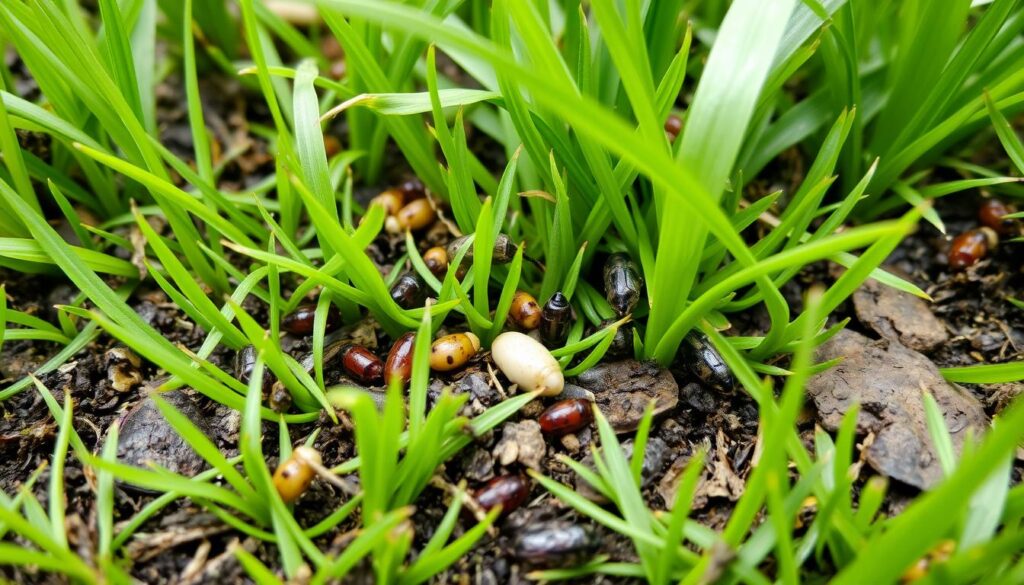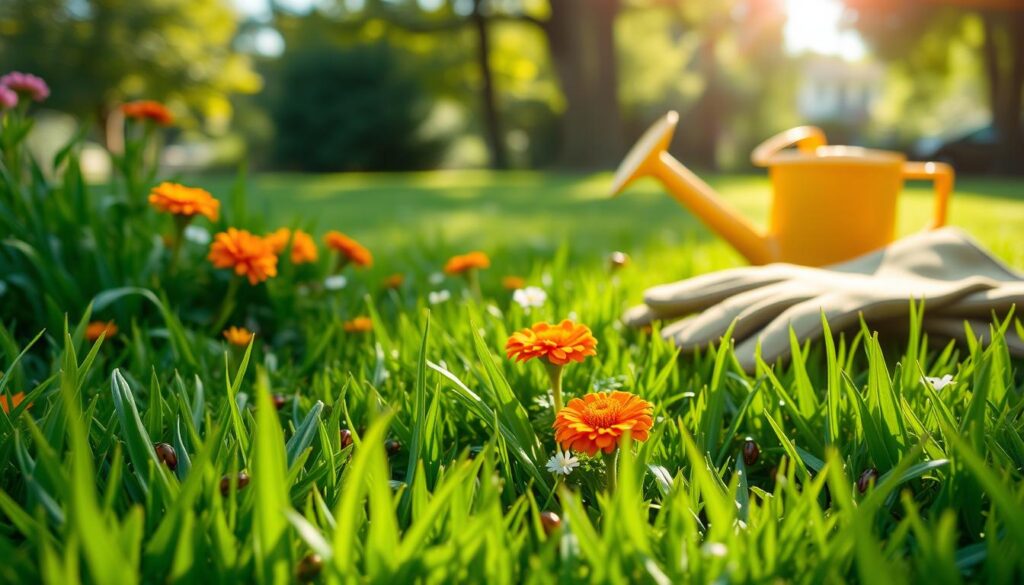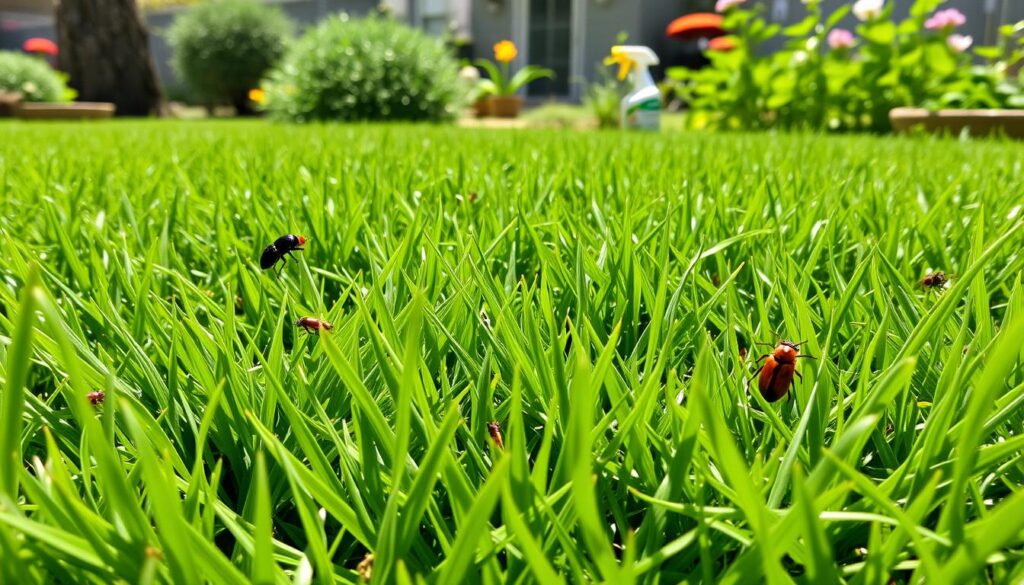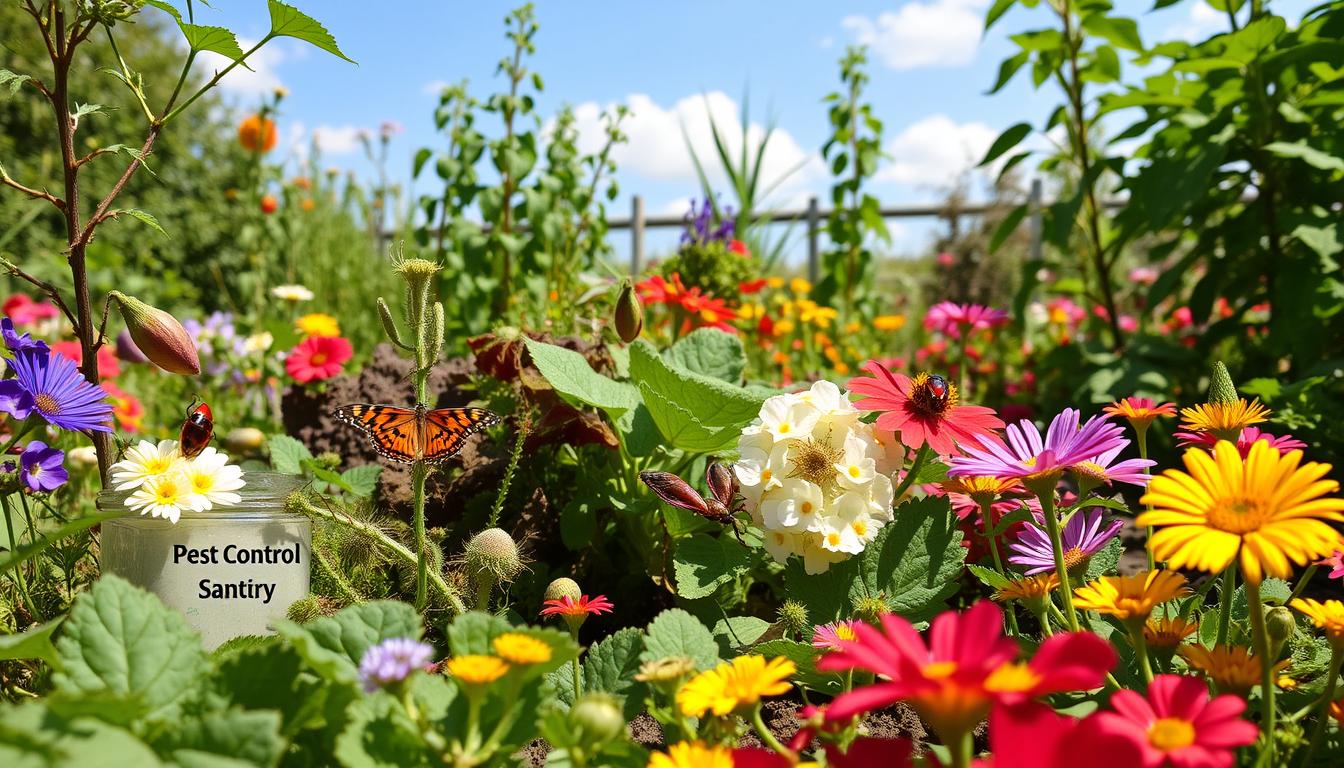As the sun rises in Florida, Sarah looks out at her beautiful lawn. It’s a source of pride for her family. But, her peace is broken by tiny insects on the grass. Sarah knows she must act fast to protect her lawn from pests.
Keeping a lawn healthy is a big job. It needs careful care to fight off pests. Pests like white grubs and chinch bugs can harm your lawn. But, with the right care, you can keep your lawn pest-free.
Key Takeaways
- Proper lawn maintenance, including mowing, watering, and fertilizing, is essential for preventing pest infestations.
- Identifying and addressing common lawn pests, such as chinch bugs and sod webworms, can help mitigate damage to your turf.
- Adopting a comprehensive lawn care strategy, including organic and natural methods, can effectively protect your lawn from destructive pests.
- Seeking professional lawn care services can ensure your yard remains lush, green, and resilient against a range of lawn pests.
- Maintaining a healthy, well-nourished lawn is key to deterring pests and promoting a beautiful outdoor living space.

Understanding Common Lawn Pests and Their Impact
Keeping your lawn green and healthy means watching out for pests. Grubs and chinch bugs are just a few pests that can harm your lawn. Knowing about these pests, their signs, and when they are most active is key to keeping your lawn safe.
Types of Destructive Lawn Insects
Grubs, chinch bugs, sod webworms, armyworms, and cutworms are common pests. Grubs damage grass roots, causing it to wilt and turn brown. Chinch bugs suck grass sap, leading to purple spots that wilt and turn brown.
Sod webworms eat grass blades, leaving brown spots. Armyworms and cutworms eat grass, causing bare spots. Knowing about these pests and their life cycles is important for controlling them.
Signs of Pest Infestation
Spotting pest problems early is crucial for lawn care. Look for wilted, discolored, or thinning grass. Also, watch for insects or their larvae. Regularly checking your lawn can help you catch problems before they get worse.
Seasonal Pest Patterns
Pests have their own seasons. Grubs are active in late summer and early fall. Chinch bugs prefer the hot, dry summer. Knowing these patterns helps you prepare and keep your lawn pest-free all year.
“Proactive pest management is the key to maintaining a lush, healthy lawn. By identifying common lawn insects and understanding their life cycles, homeowners can take targeted actions to prevent and control infestations.”
Essential Lawn Maintenance Practices
To keep your lawn lush and healthy, you need to pay close attention to several key practices. Mowing, watering, and fertilizing are the main steps to a thriving lawn. By sticking to these practices, your lawn will stay green, vibrant, and strong against pests and environmental issues.
Proper Mowing Techniques
Mowing your lawn right is key to its health. Always cut no more than one-third of the grass blade’s height at once. This keeps the grass healthy and its roots strong. Keep your mowing height between 2.5 and 3.5 inches for the best results.
Watering Guidelines
Watering your lawn correctly is vital for a lush, green look. Most lawns need 1 to 1.5 inches of water each week, from rain or watering. Water between 6 and 10 a.m. to reduce evaporation and let the water soak into the soil.
Fertilization Schedule
Fertilizing in the spring and fall boosts your lawn’s growth and color. Use a balanced fertilizer with nitrogen, phosphorus, and potassium. This, along with aeration and overseeding, will greatly improve your lawn’s health and strength.
| Lawn Care Practice | Recommended Approach |
|---|---|
| Mowing Height | 2.5 to 3.5 inches |
| Weekly Water Requirement | 1 to 1.5 inches |
| Best Watering Time | 6 to 10 a.m. |
| Fertilization Schedule | Spring and Fall |
Following these essential lawn care practices will help you achieve a lush, vibrant lawn. Proper mowing, watering, and fertilizing will make your lawn a source of pride and enjoyment for years. It will also help it fight off pests and environmental stress.

How to Protect Your Lawn from Common Pests
To keep your lawn looking great, you need to fight pests like grubs, chinch bugs, and sod webworms. These pests can damage your grass, making it weak and discolored. A good plan is key to keeping your lawn safe.
First, know which pests are after your lawn. Different pests eat and live in different ways. For example, grubs chew holes, while chinch bugs suck out plant juices.
Spotting pests early is important. This way, you can stop them before they cause too much harm. You might use natural helpers or safe, organic pest killers.
Good lawn care is also vital. This means:
- Mowing at the right height
- Watering and fertilizing right
- Aerating to help roots breathe
- Removing thatch to stop pests and diseases
Using a mix of prevention, natural methods, and targeted treatments is the best way to fight pests. A healthy lawn is your best defense against pests.
| Lawn Pest | Feeding Mechanism | Signs of Infestation | Recommended Control |
|---|---|---|---|
| White Grubs | Chewing mouthparts | Wilting, discolored patches, easy turf removal | Beneficial nematodes, insecticidal treatments |
| Chinch Bugs | Piercing-sucking mouthparts | Discolored, dried-out patches | Insecticidal soap, natural predators |
| Sod Webworms | Chewing mouthparts | Irregular patches of brown, dying grass | Bacillus thuringiensis (Bt) treatments, cultural controls |

“A healthy, well-maintained lawn is the best defense against pest infestations.” – Lawn Care Expert
Natural and Organic Pest Control Methods
Keeping your lawn healthy and pest-free is possible with natural and organic methods. Using beneficial insects and nematodes, like ladybugs and lacewings, can control pests. These natural predators eat pests like aphids and caterpillars, keeping their numbers down.
Beneficial Insects and Nematodes
Organic repellents, like neem oil and diatomaceous earth, are also effective. Neem oil, from the Azadirachta indica tree, controls many pests. It’s applied every 7 to 14 days to fight pests.
Diatomaceous earth is a mineral that targets pests like grasshoppers and fleas. It’s safe for the environment and effective against many pests.
Organic Repellents
Cultural control practices also help keep pests away. Healthy soil, made better with compost and mulch, fights pests. Plants like marigolds repel pests when placed right.
Garlic, hot pepper sprays, and essential oils also repel pests. These methods are safe and keep your lawn healthy. A natural approach to lawn care manages pests and supports a sustainable landscape.
Cultural Control Practices
FAQ
What are the benefits of a well-maintained lawn?
A well-maintained lawn makes your property look better. It also serves as a great outdoor space. Plus, it traps dust, prevents erosion, and improves the air quality.
What are the key lawn care practices for a healthy lawn?
Key practices include mowing, watering, and fertilizing. You also need to control weeds, manage pests, aerate, and overseed. These steps help your lawn stay lush and green, fighting off pests and diseases.
What are some common lawn pests and their impact?
Common pests are grubs, chinch bugs, and sod webworms. Armyworms and cutworms are also common. They damage grass roots, suck sap, and eat grass blades and stems. This can cause wilted, brown patches.
How should you properly mow, water, and fertilize your lawn?
When mowing, cut no more than one-third of the grass blade’s height. Keep it between 2.5 to 3.5 inches tall. Water deeply but infrequently, aiming for 1 to 1.5 inches of water per week. Water between 6 and 10 a.m. Fertilize in spring and fall with a mix of nitrogen, phosphorus, and potassium.
What are the best strategies for protecting your lawn from pests?
Protecting your lawn from pests requires prevention and treatment. Regular maintenance and early pest detection are key. Use integrated pest management, like introducing beneficial insects and nematodes, organic repellents, and cultural control practices.
What are some natural and organic pest control methods for lawns?
Natural methods include introducing beneficial insects and nematodes. Use organic repellents like neem oil or diatomaceous earth. Also, practice good lawn maintenance and strategic landscape planning to make your lawn less appealing to pests.




